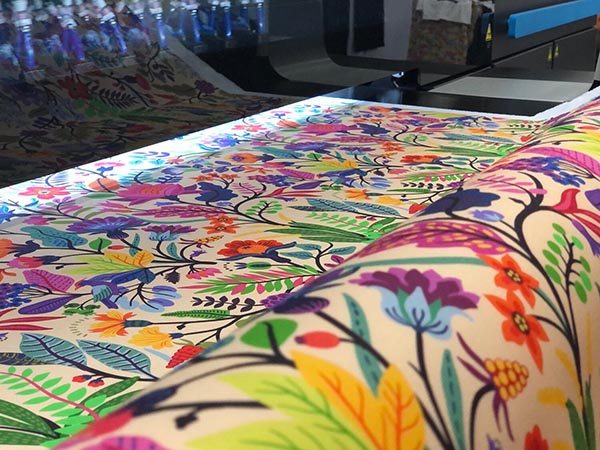
Image Credit: Kornit Digital
In the current climate, the challenges of supply chain uncertainty have forced many of us to both revisit and perhaps move to reconfigure our supply base in order to protect against future exposure and business interruption. But do we need to do more than just seek diversity? Do we not need to radically restructure our manufacturing processes?
As the world’s textile industry looks to resolve the current health challenges, and battle with supply chain disruption, these unprecedented events are going to force a radical reset. Globally the world is united, and everyone faces the same dilemma. As history has shown, we often need an out-of-the-ordinary environment to force us to leave our comfort zones; we are all forced out of the comfortable “normal.”
A Sustainable Supply Chain Addresses a New Textile Paradigm and the Future of Production

Digital textile printing technologies offer the supply chain reduced inventory and lean manufacturing. Is it time to think beyond the constraints of your existing production legacy and re-equip? (Image Credit: Kornit Digital)
The current textile supply chain is both complex and global, with an extensive carbon footprint, but that doesn’t have to be the case. The Silk Roads of the past don’t address the needs of an eco-conscious generation, so we need to re-establish new, carbon-efficient vendor chains and move towards sustainable supply. Building a future-safe supply chain will empower flexibility in uncertain times and will become a critical factor in future pandemic business plans across all industries.
Manufacturers, regardless of location, need a new flexible toolbox, built to reverse the negative impact of channel disruption and equipped to flex and meet the demands of a new marketplace. Is it time to think beyond the constraints of your existing production legacy and re-equip?
Digital technologies offer a suite of tools for retailers and manufacturers that harness and deliver the associated benefits of sustainable customized production—the new Digital Silk Road.
As the fashion industry labors to meet the requirements of a new generation of consumers and a demand for product diversity together with sustainability, the traditional stock workflow is no longer relevant; it resides in the past. The current fashion cycle and its supply chain must adapt; it must reset and free itself from legacy production. As an industry sector, fast fashion accounts for more than its fair share of the world’s pollution, ranking second as a global polluter and consumer of the Earth’s natural resources.
In a fast-paced world, we now demand instant supply, forcing many brands and retailers with complex supply chains to hold stock. However, overstocks are bad news for businesses large and small, and must be controlled and fine-tuned to meet demand. On the other hand, out-of-stocks are lost sales. So what’s the solution?
Fulfillment must be managed to secure sales and meet demand, and, importantly, retain the customer loyalty you have worked so hard to create. Customized production and the benefits of a lean, efficient supply chain utilizing digital technologies, release the energy of on-demand production and free the supply chain from burdensome stock.
Real-Time Data Drives “Just-In-Time” Manufacturing and Reduces Inventory and Risk

The digital smart factory utilizes a suite of technologies that facilitate “just-in-time” manufacturing. Driven by collaborative data from deep within the supply chain, the manufacturer has access to the technologies and the necessary information to provide flexible, efficient production and generate customized orders, at any scale, manufactured to meet client demand.
A digitized workflow delivers real-time information and allows both the retailer and the manufacturer to flex production to meet market demand and supply chain interruption. To do so it must be transparent and unite all stakeholders.
In general, the textile industry has faced up to its accountabilities and welcomes a new, positive era of change and a generational swing towards sustainability. But to change the practices and production processes of the past takes time, while both the industry and the consumer are impatient for change. The supply chain must also adapt to offer best practice and re-equip as required for sustainable supply to meet the industry’s requirements.
The most successful brands are those that offer intense diversity and flexible production, manufacturing in real time, using intelligent metrics; and to do so they operate using digital technologies. Utilizing a digital workflow offers essential control and it reaps cash rewards, with the commercial benefits of efficient production.
The manufacturer must now adapt to a new workflow, one that can and will change the future of textile production, and in doing so, will deliver sustainable manufacturing.
The digital smart factory utilizes a suite of technologies that facilitate just-in-time manufacturing. Driven by collaborative data from deep within the supply chain, the manufacturer has access to the technologies and the necessary information to provide flexible, efficient production and generate customized orders, at any scale, manufactured to meet client demand.
Carbon neutrality is a must for the supply chains of the future. Together with the benefits of speed and ultimate flexibility, near-shore production also simplifies the value chain and offers a reduced carbon footprint. Reduced inventory, ultimate control, and automatic stock regeneration now also reduce the requirement for carried stock, as well as the requirement for large-scale warehousing and, importantly, free redundant capital by taking back control of the supply chain.
Building Digitized Communication Allows Businesses to Take Control of the Supply Chain

In a virtual, digitized world, web-to-print solutions offer an automated print workflow, with no human intervention or administration and represents the only true platform for sustainable production.
Cloud-based solutions support the industry’s growth within both physical retail stores and the virtual e-commerce marketplace and are essential to all stakeholders as they offer real-time metrics that can accurately predict sales. The buyer is now electronic, placing orders into a production mainframe that’s purposely built for customized manufacturing to service accurate demand, on demand.
In a virtual, digitized world, web-to-print solutions offer an automated print workflow, with no human intervention for administration. Stocks, consumables, print orders, and shipping are automated, and, importantly, are only delivered into the production cycle when triggered by the sale—print on demand, by definition, delivered at speed to an online consumer. Third-party fulfillment offers a hands-free production process and meets the demands of the e-commerce marketplace.
As we move forward into a new era of consumer-driven transparency, the fashion industry and its supply base have the technology at their fingertips to deliver a sustainable solution and bring about change. The requirement for sustainable supply and the operational efficiencies of the digital workflow offer the fashion industry new entrepreneurial growth at any scale.
As the current climate now teaches us, we must restructure our supply chains and adapt to new environments, embrace digital disruption, and prepare the textile industry for a sustainable, digital future.














